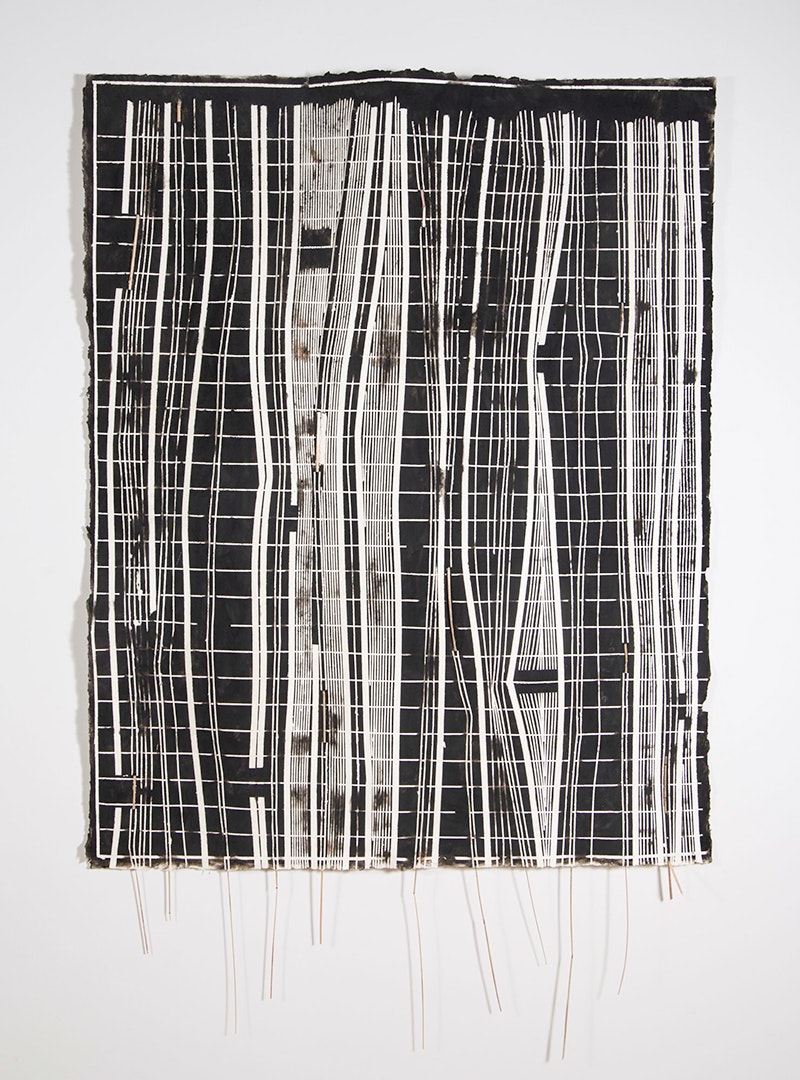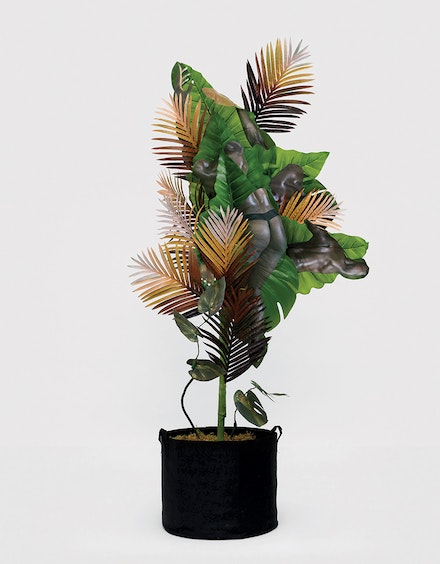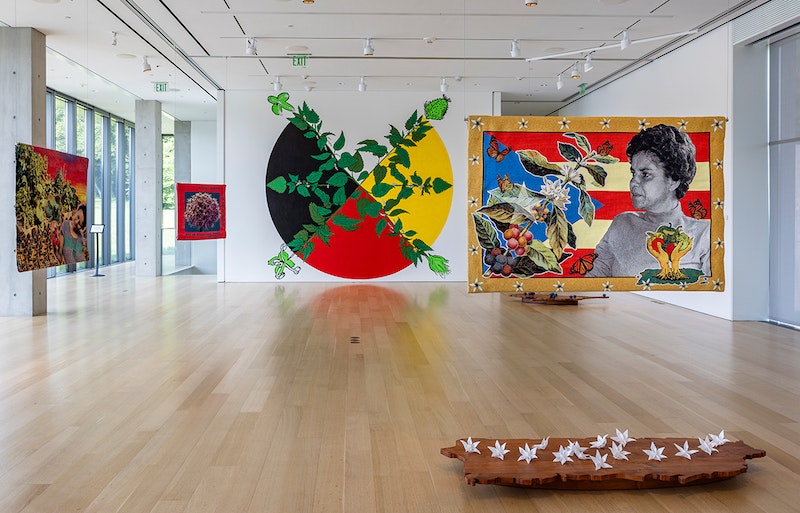
- Source: THE BROOKLYN RAIL
- Author: William Corwin
- Date: OCTOBER 4, 2023
- Format: DIGITAL
Humane Ecology: Eight Positions

Christine Howard Sandoval, Ignition Pattern 1: Density, 2023. Soot, bear grass, handmade paper, 74 × 48 × 2 inches.
Humane Ecology is an environmental variety show. The practices of eight very different artists are corralled into a loose association under the themes of social justice, environmental justice, Indigenous practices, and representation of natural materials and/or use of natural materials. The artists do share similar strategies and techniques, such as reliance on natural forms and textures, employed by Juan Antonio Olivares, Allison Janae Hamilton, and Eddie Rodolfo Aparicio who utilize shells, amphibious reptiles, and tree bark, respectively. Others like Kandis Williams, Carolina Caycedo, and Pallavi Sen integrate vegetation and its symbolism as a subject or means of presentation in the work. The exploration of humans’ relationship to nature makes the exhibition a survey of sorts, riffing on the vague genre of environmental art, a syllabary of themes and methods.
Carolina Caycedo depicts specific locations, individuals, and species, which are worthy of commemoration in her installation of banners, murals, and text works. We Save Our Seed for the Following Season / Cada sorbo de café será una bendición para ti (Tinti) (2023) is a Jacquard tapestry depicting Faustina “Tinti” Deyá Díaz (1940–2021), founder of the organization Casa Pueblo, along with associated attributes such as butterflies and coffee plants. Casa Pueblo prevented the excavations of open pit mines in central Puerto Rico, supporting alternative industries such as butterfly and coffee farming as well as solar-powered farms. Caycedo’s focus on tapestries rejects landscape painting as a western genre and an intrusion into South and Central American culture, herself offering an alternative. Allison Janae Hamilton similarly interweaves several familiar motifs and location-specific signifiers in her arresting pair of alligator “Ouroboros” sculptures Untitled (White Ouroboros) (2023), which sit outside the gallery space and menace the viewer from outside the windows. The ancient ouroboros symbol is effective in depicting both the connectedness of environmental networks and their destruction. Hamilton also brilliantly employs the traditional Floridian mascot of wildness and danger (the Gator), while playing it as a dark coded reference to Florida’s traditions of white supremacy (Gator Bait). She instrumentalizes the fearsome amphibian as a symbol of the immediate repercussions of climate change-induced-chaos: the expansion of the alligator’s habitat far into northern waters.
Eddie Rodolfo Aparicio utilizes latex as a visceral and gritty means to reproduce the wounds, graffiti, and natural topology of bark into gorgeous curtains of elastic bark-like flesh. But these incredibly detailed swathes also conjure references to the means of production—the present-day slave-like conditions of Indigenous workers in Guatemala. While they are forbidding and encrusted, they are also soft and pliable, both horrifically human and morbidly natural. This closeness and relatability of texture is shared by Christine Howard Sandoval’s labyrinthine, off-kilter geometric studies of soot and adobe mud on paper. Crisp and clean lines of blank paper alternate with accumulations of dirt, mimicking the face of nature but this time resonating with dried river beds in the California badlands, banal highways, geologic striations, and even the warp and weft of Indigenous weaving.

Kandis Williams, Genes, not Genius: The overlying purpose is to address how the social production of biologically determinist racial scripts—which extend from a biocentric conception of the human—can be dislodged by bringing studies of blackness in/and science into conversation with autopoiesis, black Atlantic livingness, weights and measures, and poetry. A biocentric conception of the human, it should be noted up front, refers to the law-like order of knowledge that posits a Darwinian narrative of the human—that we are purely biological and bioevolutionary beings—as universal; elegance is elimination, 2021. Collage on artificial plant, fabric grow bag with moss, plastic 92 × 41 × 18 inches. Courtesy the artist and Morán Morán, Los Angeles/Mexico City.
Side-by-side in the gallery are Kandis Williams’s plastic trees and Juan Antonio Olivares’s hanging garden of molluscs. Williams’s trees Genes, not Genius: For jazz is orgasm… (2021) and Genes, not Genius: The overlying purpose… (2021) sport both realistic leaves and clippings from magazines depicting nude and semi-nude Black bodies, a gesture that reflects on the reproducibility and inevitability of the use of sexuality and the body in strategies of oppression, surveillance, and control. Olivares’s Fermi Paradox III (2019) consists of shells from a variety of species dangling at different heights and piped in recordings of various thinkers, scientists and artists, from the sage, like Stephen Hawking and Nina Simone, to the mad, like Bob Lazar. Emerging from the shells is a false sense of equality, a democratic wash of voices that perhaps alludes to the dangers of both received wisdom and populism. Less focused is Korakrit Arunanondchai’s Songs for dying (2021), a thirty-minute video that meanders among various popular and semi-autobiographical themes: shamanism, contemporary political upheaval in Thailand, historic crimes against humanity in South Korea, and the death of the artist’s beloved grandfather. There is the sense that each of these artists could have served as the sourdough starter for a more explicit show pursuing the specific set of ideas with which they engage.

Installation view: Humane Ecology: Eight Positions, Clark Art Institute, 2023. Courtesy the artist and Instituto de Visión, Bogotá/New York.
The most arresting and poignant statement integrating artistic expression and the environment is Pallavi Sen’s verdant and lovely, yet dystopian Garden of Eden, Experimental Greens: Trellis Composition (2023); it provides a bucolic place to walk after trekking from the main building of the Clark Art Institute up to the annex on the hill, offering refuge from the heat. But Sen’s garden presents one of the ironies of climate change—she has imported non-native crops to the New England ecosystem because these species, used in Indian farming, are heartier and far better suited to the now more humid and hot climate of New England. Is this practice of integrating potentially invasive species a bad idea or a last resort? Like many of the other works in Humane Ecology, which look at desperate choices in a broken world, Sen makes these cruel decisions look beautiful.

